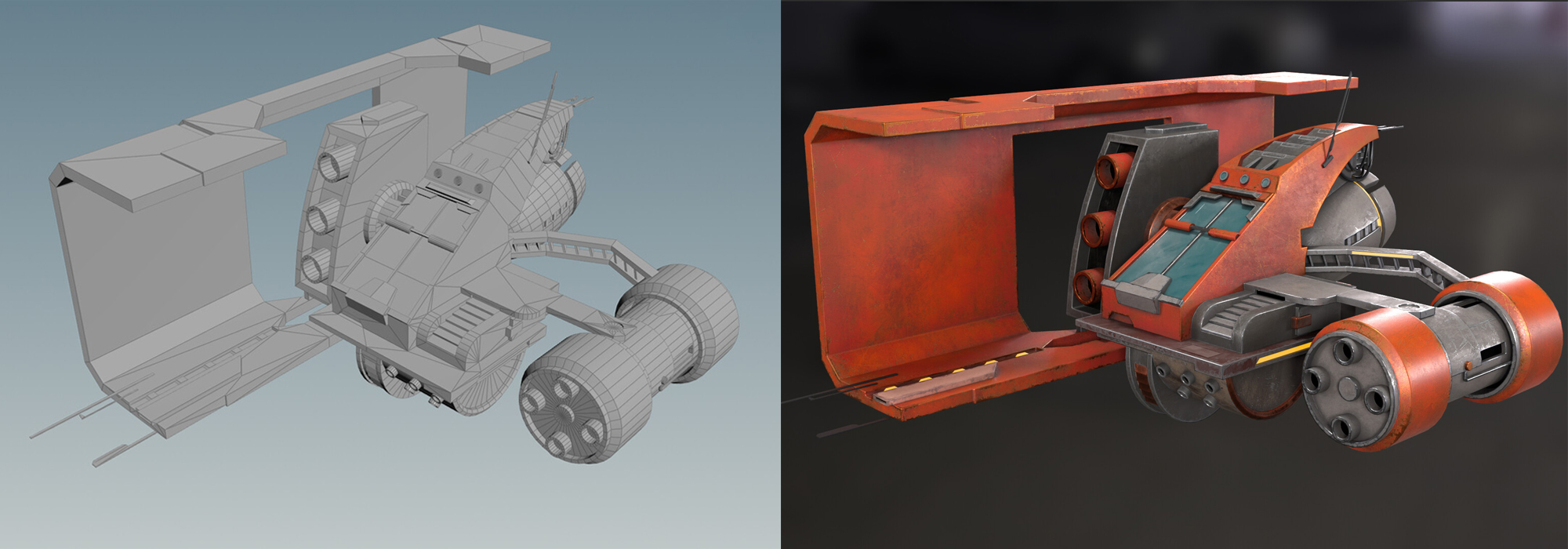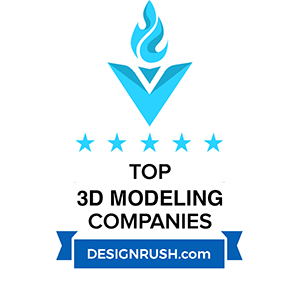As technological advancements continue to drive innovation, computer-generated imagery (CGI) has found a critical role across a plethora of industries, spanning from game development to automotive design, healthcare, and architectural visualization. The modern commercial landscape is becoming increasingly dependent on the process of 3D rendering and 3D model rendering services due to their ability to reduce cost, facilitate early-stage error detection, and enable a dynamic preview of the final product before physical realization.
Thanks to the multitude of available 3D modeling services, businesses today can effortlessly display their product in a digital or virtual setting, bypassing the need for massive investment in crafting a physical prototype. By rendering 3D models of a proposed infrastructure, product, or complex mechanical system, companies can promptly identify potential issues before incurring substantial manufacturing costs.
Therefore, the process of rendering a 3D model offers a swifter and more financially sensible alternative to creating a tangible prototype in the real world. As we delve further into this discourse, we’ll examine why many businesses are capitalizing on 3D rendering and 3D model rendering services and the multitude of benefits this advanced technology confers.
What Is 3D Rendering? — The Fundamentals
When we delve into 3D modeling, the term ‘rendering’ often surfaces. So, what exactly does it encompass? While sculpting or fabricating three-dimensional digital artifacts using polygons stands as one stage of the process, 3D rendering is a subsequent phase that brings these models to life. It’s a process that involves generating realistic depictions or snapshots of previously constructed 3D models, complete with textures, light, shadows and an array of post-processing effects. By this definition, we can identify the rendering process as the concluding step in the extensive journey of 3D modeling.
If you are seeking an efficient and high-quality outcome at the pre-production stage, rendering 3D models can prove to be a significant asset. Equipped with the right software tools, such as Blender, 3ds Max, and Autodesk Maya, among others, and powered by robust GPU and CPU technology, a 3D model can be rendered within weeks. It’s imperative to remember that this phase typically falls under the purview of a team dedicated to the creation process, and as such, owners shouldn’t feel obliged to manage this aspect.
In the present day, virtually every piece of software designed for 3D modeling also facilitates the rendering of the image. Therefore, the initial step towards achieving a fully-rendered three-dimensional model — be it of a house, interior design, device, or anything else — involves the actual modeling of the entity using a series of points known as vertices, interconnected into edges and faces.
More Light on 3D Rendering
3D artists are typically proficient across the full spectrum of the modeling and rendering pipeline. This implies they comprehensively understand the process, from initial model construction to the final rendering stage. So, the intricate details of the pipeline are usually well within their grasp.
- 3D artists are typically proficient across the full spectrum of the modeling and rendering pipeline. This implies they comprehensively understand the process, from initial model construction to the final rendering stage. So, the intricate details of the pipeline are usually well within their grasp.
- 3D model rendering is the key to enhanced visualization. Whether it’s for project proposals, design evaluations, or customer presentations, a rendered 3D model presents a realistic and comprehensive perspective of the intended product or structure.
- Rendering services are a valuable resource. For businesses that lack the in-house capacity or resources for 3D rendering, outsourcing to dedicated rendering services can ensure high-quality, professional results that align with their specific needs and timelines.
Navigating the complex world of 3D modeling and rendering can indeed be daunting, but with the proper understanding and resources, the process becomes significantly more manageable and efficient.
Step into the breathtaking world of 3D modeling and rendering, where creativity merges with technology to create immersive experiences that transcend the boundaries of physical reality. Here, polygons evolve into intricate 3D models, meticulously crafted down to the finest detail. As the story unfolds, we dive deeper into the narrative with the transformative process of 3D rendering.
Imagine watching your vision come to life through the lens of 3D model rendering, where each digital object acquires a persona of its own through texture, light, and shadows. Envision a sun-drenched room, with golden light streaming through the windows, casting long, languid shadows that dance across a well-worn wooden floor.
Picture the mesmerizing interplay of light and texture on a chrome-plated gadget or the weathered exterior of an ancient ruin, its rich history etched in every stone. These are not mere illusions but products of the rendering process, an art form that transforms abstract models into tangible, vibrant realities.
Each 3D model rendering is an invitation to embark on a journey of discovery, an exploration of unseen realms and forgotten narratives. It’s an adrenaline rush, a quest that pits the limits of human imagination against the boundless potential of technology. Engaging with 3D rendering is not just an act of creation but a vibrant dance in the amphitheater of virtual reality. And when the music fades, we are left with a symphony of pixels that teem with life, whispering the secrets of forgotten realms and futuristic landscapes.
So, whether you are a creator or a viewer, prepare to be enthralled by the captivating power of 3D rendering, the ultimate art form of the digital era.
3D Rendering Vs 3D Modeling
| 3D Modeling | 3D Rendering | |
| Definition | 3D modeling is the process of creating a three-dimensional object or scene. It is the first stage in the CGI creation pipeline, laying the groundwork for subsequent processes. | 3D rendering is the process of converting 3D models into 2D images or animations, complete with lighting, texture, and shadow effects. It’s the final stage in the CGI pipeline that brings a 3D model to life. |
| Process | The 3D modeling process involves the creation of geometric, wireframe representations of objects. Polygons are sculpted, adjusted, and textured to form a 3D model. | The 3D rendering process involves calculating effects, like lighting, shadows, textures, and other visual aspects to produce an image or animation from a 3D model. This step brings photorealism to the 3D model. |
| Usage | 3D modeling is used extensively in industries like game development, animation, architecture, and product design. It forms the basis of any 3D character design or game art. | 3D rendering is crucial in visualizing realistic final designs. It’s used in game development, architectural visualization, animations, and more. 3D model rendering can also showcase game art. |
| Services | 3D modeling services include the creation of 3D characters, game assets, architectural designs, and more. These services are often provided by a 3D modeling company. | Rendering services transform 3D models into photorealistic images or animations. These services may include 3D model rendering, architectural rendering, product rendering, and more. |
In the ever-evolving world of digital art, 3D modeling and 3D rendering are two sides of the same coin, each possessing its own unique traits and complexities. Though different, these two processes coalesce seamlessly to create compelling computer-generated imagery (CGI) that we often marvel at in our everyday digital experiences.
-
3D modeling. As an intricate process of sculpting a 3D model, it forms the groundwork of any CGI creation. This digital artistry involves an artist carefully shaping and manipulating polygons to create an object in a virtual, three-dimensional space. Through 3D modeling, designers breathe the initial life into an idea, molding it into a tangible form that can be further refined and enhanced. Whether it’s the latest game character or an architectural marvel, it all begins with 3D modeling.
-
3D model rendering. The story of a 3D model does not end at its creation. This is where 3D rendering enters the scene, a crucial step that transforms a 3D model into a photorealistic image. During the 3D rendering process, lighting, texture, shadows, and other post-processing effects are added to the model, granting it a lifelike, captivating, and convincing appearance.
It’s crucial to understand that the path from 3D modeling to 3D rendering isn’t a solitary journey but a collaborative one. The success of the rendering process is heavily reliant on the accuracy of the initial 3D model. Furthermore, the effectiveness of 3D model rendering can greatly enhance or diminish the appeal of the original model, making this interplay between modeling and rendering a crucial aspect of CGI creation.
Riding on this synergy between 3D modeling and 3D rendering, many industries, from gaming to architecture, avail of 3D rendering services to visualize, refine, and perfect their creations before they become reality. It’s this intricate dance of creation and enhancement that makes 3D modeling and 3D rendering the dynamic duo of the digital art world.
Remember, in the grand scheme of CGI creation, one process cannot exist without the other. They are two parts of a whole that, together, create the breathtaking digital art that we see in our games, movies, and more.
Types of 3D Rendering
In the ever-evolving landscape of digital visualization, the prominence of 3D rendering is proliferating. This technique, whether it’s leveraged to create vibrant cartoons or achieve photorealistic rendering, serves as a dynamic and cost-effective tool for an extensive range of applications. By optimizing the product lifecycle and minimizing expenses related to pre-production, 3D rendering significantly enhances efficiency in various industries.
Broadly speaking, 3D rendering can be bifurcated into two core types — real-time rendering and post-process rendering. Real-time 3D rendering unfolds at the moment as dedicated graphics software generates and evaluates CGI. This process involves employing mathematical algorithms to convert 3D wireframe models into 2D images with photorealistic effects. In contrast, post-process 3D rendering takes place following the initial output’s approval by a 3D artist. It involves further refinement and manipulation of the rendered model to create a highly polished end product.
Delving deeper, 3D rendering techniques can be demarcated into two additional categories — static and interactive, based on the interaction level they provide:
1. Static rendering involves creating a 3D model or scene that offers a stationary perspective. Examples of this include:
-
White background rendering. A prevalent method in e-commerce, it showcases fully textured and completed 3D models against a stark white backdrop, accentuating the model’s details.
-
Roomset renders. This technique generates photorealistic environments, presenting the product as though it exists in a physical space, offering viewers an immersive experience.
2. Interactive rendering enhances user engagement by enabling interaction with the rendered 3D scene:
-
360-degree view. Offering a comprehensive perspective, this method allows potential buyers to rotate a model in a series of rendered images or multi-row 3D views, delivering a superior shopping experience.
-
Product 3D animation. It produces a video recording of a pre-rendered scene, frequently utilized to advertise a range of products, from innovative architectural designs to high-tech devices like smartphones.
-
Product configurator. Arguably the most intricate rendering type, it facilitates extensive product customization, empowering potential buyers to tweak an item’s specifications to their liking.
Moreover, within the realm of real-time rendering, there are myriad 3D rendering methods to choose from:
-
Scanline rendering. Based on a polygon-by-polygon principle, this method is capable of rendering objects at an impressive rate of 60 frames per second using precomputed lighting, making it suitable for real-time applications.
-
Ray tracing. Employing complex 3D rendering algorithms, ray tracing accurately simulates the behavior of light, tracing the refraction or reflection of the materials utilized in a 3D scene, thus delivering visually captivating and realistic results.
-
Ray casting. This method, which operates on a pixel-by-pixel basis, is particularly beneficial for projects where minute details are not a priority.
On the whole, the domain of 3D model rendering and the encompassing rendering process is rife with various pathways to breathe life into your envisioned models. Regardless of whether you are a business seeking top-tier rendering services or a 3D artist exploring new techniques, the potential of 3D rendering to revolutionize your work is undeniable.
How Does 3D Rendering Work?

In digital imaging, the parallels between 3D rendering and conventional photography are indeed significant. With the advent of sophisticated rendering software, digital artists are now able to orchestrate scenes and capture them from various angles, just like a photographer would with a camera. However, this 3D rendering process necessitates much more than a mere click of a button in 3D software like Blender or 3ds Max. If you are curious about how to create captivating 3D renders, the response is relatively straightforward, yet understanding the underlying mechanics is indispensable.
Commencing your creative journey involves constructing a 3D model within the virtual workspace of your chosen software. Post this modeling phase, you can initiate the 3D rendering process, which involves incorporating a medley of elements such as shadows, lights, textures, and various special effects to breathe life into your scene or model. This 3D rendering process, while complex, forms the bedrock of modern visual imagery.
An understanding of the evolution of 3D rendering offers a glimpse into the intricacies involved — the pioneering effort of Ivan Sutherland. In 1963, Ivan Sutherland broke new ground in the field of 3D modeling when he came up with Sketchpad, marking the inception of 3D modeling software. This development was built on the initial emergence of rendering techniques in 1960, which was originally purposed for portraying pilots in cockpits.
The rendering process is designed to mimic how light behaves in real-life situations, illuminating physical objects to make them discernible to the human eye. Simplistically put, a 3D model undergoes a transformation into a fully rendered Computer-Generated Imagery (CGI) through the ‘lens’ of a virtual camera that ‘records’ the scene or object. High-quality 3D rendering walks a fine line, maintaining a delicate equilibrium between quality, data size, speed, realism, and resolution. Creating a 3D render that can effectively market products, rather than merely appealingly presenting them, necessitates a certain degree of artistic flair.
Key considerations include:
-
Optimizing lighting properties. Fine-tuning the intensity and positioning of light within a scene can significantly contribute to a natural look, enhancing the 3D model rendering.
-
Incorporating high-quality materials. Selecting textures and materials that complement the overall aesthetic of the scene or object can boost the 3D model rendering. For instance, if you are digitally showcasing a pair of leather boots, utilizing appropriate textures can remarkably improve the 3D rendering.
Overall, 3D rendering services offer an amalgamation of science and art, where crafting engaging visuals is as much about understanding the technicalities as it is about unleashing your creativity. With detailed attention to every stage of the rendering process, from creating the 3D model to its final rendering, one can truly realize the power and potential of 3D modeling and rendering.
What Is 3D Rendering Used For?
Utilizing 3D modeling for pre-rendering serves as a critical step in the process of developing your product. It functions as an early warning system, revealing potential design issues before they transition into more costly problems in the later stages of production. In this context, we delve into the most significant and prevalent applications of 3D rendering, clarifying where and why you might need to deploy this dynamic software solution.
Among the numerous applications of 3D rendering, several key domains stand out:
1. Prototyping and visualization. It’s undeniable that 3D rendering, particularly 3D model rendering, plays an instrumental role in the domains of visualization and product prototyping. Its primary objective is to assist business owners in identifying and rectifying significant flaws or defects during the early stages of production.
2. Promotion, marketing, and branding. The inclusion of 360-degree 3D renders of products on your website is indispensable, not to mention the need for comprehensive 3D animations of products. These elements augment the sales potential and, as per statistics, the international visualization and 3D rendering software market was valued at $1.63 billion in 2019 and is projected to be worth over $9.5 billion by 2030. This trend indicates a significant and exponential growth trajectory.
3. Digital entertainment and gaming. For intricately designed 3D games and blockbuster movies like Avatar, rendering — especially 3D rendering — is the solitary technique that brings all the magical elements to life on screen. Thus, it’s an indispensable tool within the digital entertainment industry.
Beyond its specific use cases, it’s crucial to recognize the various industries where rendering services provide significant advantages for product owners. It does so by cutting down costs and optimizing resource utilization. Sectors such as architecture, healthcare, manufacturing, automotive, and technology are highly reliant on rendering, specifically 3D rendering, for their operations.
To elucidate further, let’s consider the example of building exterior design. But first, it’s essential to understand what 3D architectural rendering entails. In this sector, 3D modeling and prototyping are of paramount importance as they facilitate all parties to conserve resources during the planning and pre-production stages. By visualizing a house or apartment before the procurement of physical materials for construction, 3D model rendering allows for significant resource optimization and cost savings.
Through all these stages, the 3D rendering process ensures a seamless transition from a conceptual model to a tangible product. The intricate interplay between 3D modeling and rendering in multiple industries underscores the pivotal role these technologies play in our increasingly digital world.
How Much Does 3D Rendering Cost?
In the domain of 3D rendering services, the cost spectrum is incredibly broad, typically fluctuating between $100 to a staggering $10,000 per image. This considerable disparity is primarily due to the extensive range of services available within the 3D rendering landscape. 3D rendering extends to various specialties such as interior and exterior residential design, 3D floor plans, architectural animation, aerial views, amenity areas, product visualization, and many others. In essence, the potential for 3D model rendering is vast – almost any concept developed in a 3D environment can be rendered into a visually stunning image.
It’s essential to understand, however, that before embarking on the 3D rendering journey, the associated 3D models must be thoroughly prepared. This preparation is a critical prerequisite for the rendering process. Usually, this intricate dance of modeling and 3D rendering is performed by a single artist or a collaborative team of experts. These professionals work in tandem, their collective skills bringing a project from concept to completion.
The final cost of a project often depends on an amalgamation of factors, which may include a combination of modeling and rendering services complemented by the specialized skills of lighting/shading experts, animation artists, and texturing maestros. After all, the process of 3D rendering is the final stop on a journey that begins with a three-dimensional model.
When it comes to intricate renderings, such as 3D animations, costs can quickly escalate. It’s not uncommon for prices to exceed $2500 per minute, a figure that fluctuates based on a multitude of characteristics. Several key factors come into play here:
The number of polygons or the polycount. This refers to the sheer quantity of polygons that make up the 3D model, a factor that can substantially influence the complexity of the 3D model rendering process.
The desired realism. The goal of achieving an ultra-realistic output can add an extra layer of complexity to the 3D rendering process, thereby adding to the overall cost.
The intricacy of the design. This attribute straddles the realms of 3D modeling and rendering, pertaining to the level of detail and sophistication inherent within the 3D model. More complex designs often necessitate more advanced rendering processes.
The utilization of specialized techniques. The incorporation of cutting-edge techniques, such as ray tracing in the rendering process, can drive up the cost due to the additional computing power and expertise required.
Considering the wide array of variables, it becomes pivotal to have detailed discussions with your chosen provider of 3D modeling and rendering services. They are uniquely positioned to provide accurate estimates and insights into the process. These professionals have a comprehensive understanding of the various nuances and can guide you through each step of the 3D rendering journey, ensuring you receive the best value for your investment.
Conclusively, the key to successful 3D model rendering lies not only in the technical prowess of the team but also in effective and transparent communication between the client and the service provider. Understanding the client’s vision, combined with the provider’s expertise, can bring any 3D concept to life through the magic of rendering.
How Long Does it Take to Render a 3D Model?
The duration it takes to complete a 3D model rendering depends on various key factors. Before we delve into the specifics of the timeframe, it is vital to gain a comprehensive understanding of the elements that significantly impact the rendering process.
Firstly, let’s look at the factors that can affect the speed and quality of the 3D rendering process:
- The quality of shadows. Shadows play a critical role in achieving a realistic render. There are two main methods for generating shadows: ray tracing and depth maps. Depth maps offer a quicker rendering process but often come with unwanted artifacts and resolution issues. On the other hand, ray-traced shadows, which render pixel by pixel, require more time but provide a higher-quality image.
- Output resolution. The resolution of the final render can greatly impact the time it takes to complete. With most contemporary 3D rendering projects opting for high-definition 4k or even 8k resolutions, the rendering process can be considerably extended.
- Hardware specifications. The type of hardware you use for rendering, be it a Graphics Processing Unit (GPU) or a Central Processing Unit (CPU), significantly affects the speed at which your system can render an image. More often than not, the GPU is a more potent processor, so it is generally advisable to activate it within your 3D editing software.
Equipped with this understanding, it is important to note that the average architectural design project typically requires between 2 to 4 weeks for the 3D rendering process to be completed. However, this duration is not set in stone and can vary based on several additional factors:
- Scope of work. Larger or more complex projects will naturally require more time to render.
- Budget. Higher budgets may allow for more advanced rendering services or techniques, potentially increasing the rendering time.
- Team composition. A larger or more experienced team might be able to complete the 3D model rendering process more efficiently.
Thus, the process of 3D model rendering is a complex one, requiring a fine balance of various factors. From the quality of shadows to the chosen hardware, all these aspects come together to determine not only the duration of the rendering process but also the quality of the final render. It’s an art and science that combines technology and creativity to bring 3D models to life.
Professional 3D Model Rendering Software

The exciting world of 3D model rendering has experienced a surge of growth over the past few years, largely due to the advancement in the capabilities of 3D rendering software. These programs have streamlined the rendering process, allowing designers to develop and visualize their creative ideas more effectively and efficiently.
3D rendering has become vital in numerous industries, including animation, gaming, architecture, and even advertising. This technology empowers professionals and enthusiasts to transform their imaginative concepts into visually stunning realities. From architecture to video games, product designs, and movies, implementing 3D rendering services has shown to be extremely impactful.
The need for high-quality 3D model rendering has inspired the development of an array of rendering software, each equipped with unique features to meet diverse rendering needs. To aid you in making an informed choice, we delve into the intricacies of some of the top 3D rendering software available in the market:
SelfCAD
Ranked as the best overall 3D rendering software of 2023, SelfCAD presents a simple and intuitive user interface. Offering a suite of functionalities, including modeling, sculpting, and 3D rendering, SelfCAD requires only an internet connection for operation. It supports texture mapping, which is essential for creating realistic, detailed 3D models, and comes equipped with a powerful rendering engine for enhanced lighting, reflections, and shadows.
Cinema 4D
Renowned for its 3D rendering capabilities, Cinema 4D is a versatile software ideal for creating compositions and animations in addition to drawing, sculpting, and modeling. As you navigate the wide range of software, it’s crucial to understand that each caters to specific needs. Whether you’re an amateur enthusiast or a professional, the perfect 3D model rendering software awaits you.
Blender
A versatile open-source 3D rendering software, Blender supports various tools for designing, modeling, rendering, and editing. Its built-in render engine, Cycles, facilitates the creation of detailed and lifelike 3D models.
SketchUp
An excellent choice for architectural rendering, SketchUp is an easy-to-use 3D modeling and rendering program. It’s widely employed in construction, architecture, and furniture design. SketchUp also allows for 3D flythrough and walkthrough animations.
3ds Max
An industry-standard 3DS Max is celebrated for its advanced 3D rendering capabilities. Its compatibility with V-Ray and Corona Render ensures excellent performance. The software also supports the creation of intricate sceneries, volumetric animations, and realistic models.
Lumion 3D
Specially designed for architectural exteriors, Lumion 3D is highly compatible with other 3D rendering software. Its user-friendly interface and extensive library of materials make 3D model rendering a breeze.
V-Ray
V-Ray is a well-regarded 3D rendering application that caters to 3D artists of all levels. Particularly suitable for architectural visualization, V-Ray, in combination with 3ds Max, provides excellent interior rendering capabilities. Its focus on lighting and shadows aids in the creation of lifelike images.
Viz Render
Viz Render is a powerful CPU rendering software known for providing photorealistic renderings of 3D models. It’s widely used in architectural rendering, engineering, and construction industries. It is celebrated for its ability to create high-quality images with realistic lighting and shadows.
Autodesk Revit
A powerful rendering engine, Autodesk Revit employs building information modeling concepts for architectural visualizations. Revit enables 3D modeling of architectural elements, drawing of design elements, and creating custom objects.
Maxwell Render
Maxwell Render provides advanced features and photorealistic rendering quality, enabling you to create high-quality, photorealistic images with ease. It includes a powerful GPU-accelerated renderer, global illumination, and an interactive cursor.
Octane Render
Octane Render is a powerful and reliable 3D renderer that delivers high-quality results. It offers a wide range of features that make it a great choice for 3D artists and designers. It is especially acclaimed for its rendering capabilities that offer high-quality, photorealistic images with ease.
Ultimately, 3D rendering and modeling constantly evolve, with more sophisticated software hitting the market regularly. These tools, each with unique selling points, cater to different needs and expertise levels. Whether you are a novice or a seasoned professional, understanding the capabilities of these different software solutions is key to enhancing your 3D rendering results. Explore these programs, experiment, and find the one that best aligns with your 3D rendering objectives.
How 3D Model Rendering Companies Use Specific Software
3D model rendering companies leverage various software solutions to generate high-quality renders that precisely represent their clients’ ideas. They utilize this cutting-edge technology to transform simple 3D models into realistic, breathtaking visuals.
The process begins with 3D modeling. Here, a model of the object or scene is created within a 3D software environment. This 3D model serves as the foundation for the entire project. Whether it’s an architectural structure, a game character, or a product design, the model’s accuracy and quality significantly impact the final render.
Once the 3D model has been created, the rendering process commences. Rendering is an intricate process that simulates lighting and texture on the 3D model to generate a photorealistic or non-photorealistic image. This stage requires a deep understanding of lighting, material properties, and camera perspective. The right rendering software can aid significantly in achieving the desired quality.
Advancements in software technology have revolutionized the 3D model rendering process. The introduction of real-time 3D rendering capabilities has enabled designers to view their models as they create them, allowing for more dynamic and intuitive design processes. This real-time feedback streamlines the entire rendering process, enhancing the efficiency of rendering services.
3D model rendering companies have vast libraries of materials and textures at their disposal, allowing them to create highly detailed and realistic representations of their models. From the shine of a car’s surface to the grittiness of a brick wall, the texture and material attributes bring depth and realism to the 3D rendering.
The final step in the 3D rendering process involves refining and fine-tuning the image. The model’s lighting, color, texture, and overall aesthetics are adjusted until the desired result is achieved. Many 3D model rendering companies also offer post-production services, such as image composition and color grading, to further enhance the quality of the final render.
Moreover, the evolution of rendering technology has brought about a significant change in the way 3D model rendering is done. The implementation of cloud-based rendering services, for example, has allowed for the distribution of rendering tasks across multiple machines. This not only accelerates the rendering process but also provides superior-quality renders by leveraging the power of advanced server-grade hardware.
Consequently, 3D model rendering is a highly technical and complex process requiring artistic vision and technical acumen. The use of powerful 3D rendering software by these companies allows for creating stunning visuals, whether for entertainment, architectural design, advertising, or product visualization. By mastering the subtleties of the rendering process and the specific capabilities of different software solutions, 3D model rendering companies continue to push the boundaries of what’s possible in 3D visualization.
Rendering Your Models with 3D-Ace
As you see, 3D rendering is a multidimensional area of product design. In order to run a project smoothly and flawlessly, you’ll need a reliable partner. 3D-Ace is an experienced custom 2D art, animation, and 3D modeling studio with more than 10 years of professional operation. We’ve built a team of 40+ talented 2D and 3D artists with multiple specializations.
With our rendering solutions, you can be confident about timely project delivery, graphics quality, and smooth animation. Having provided a high number of polished renders to satisfied clients, we are prepared to take on your project.
Just contact us and discuss your project’s details so we can commence our work as soon as possible!










